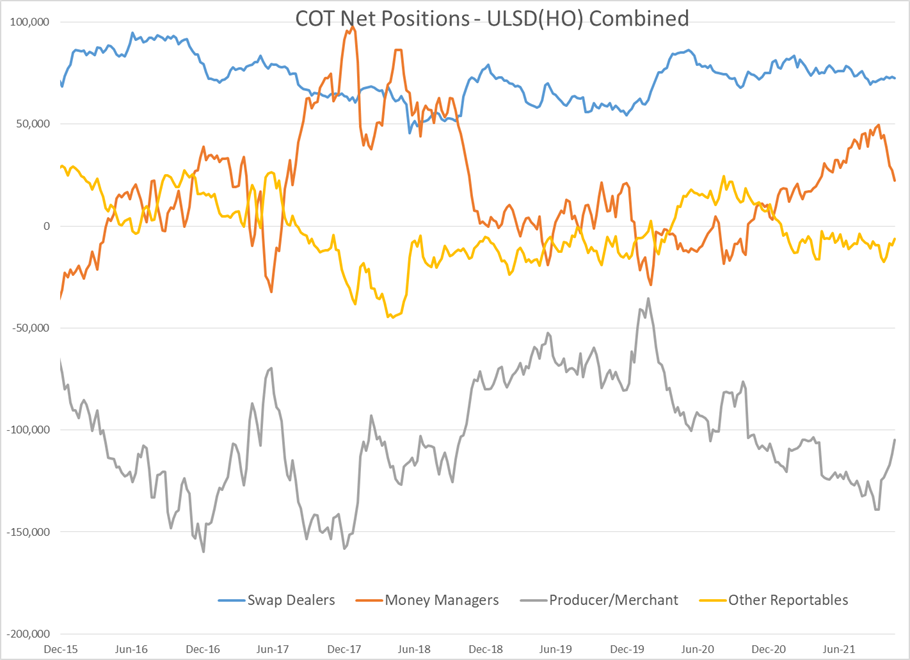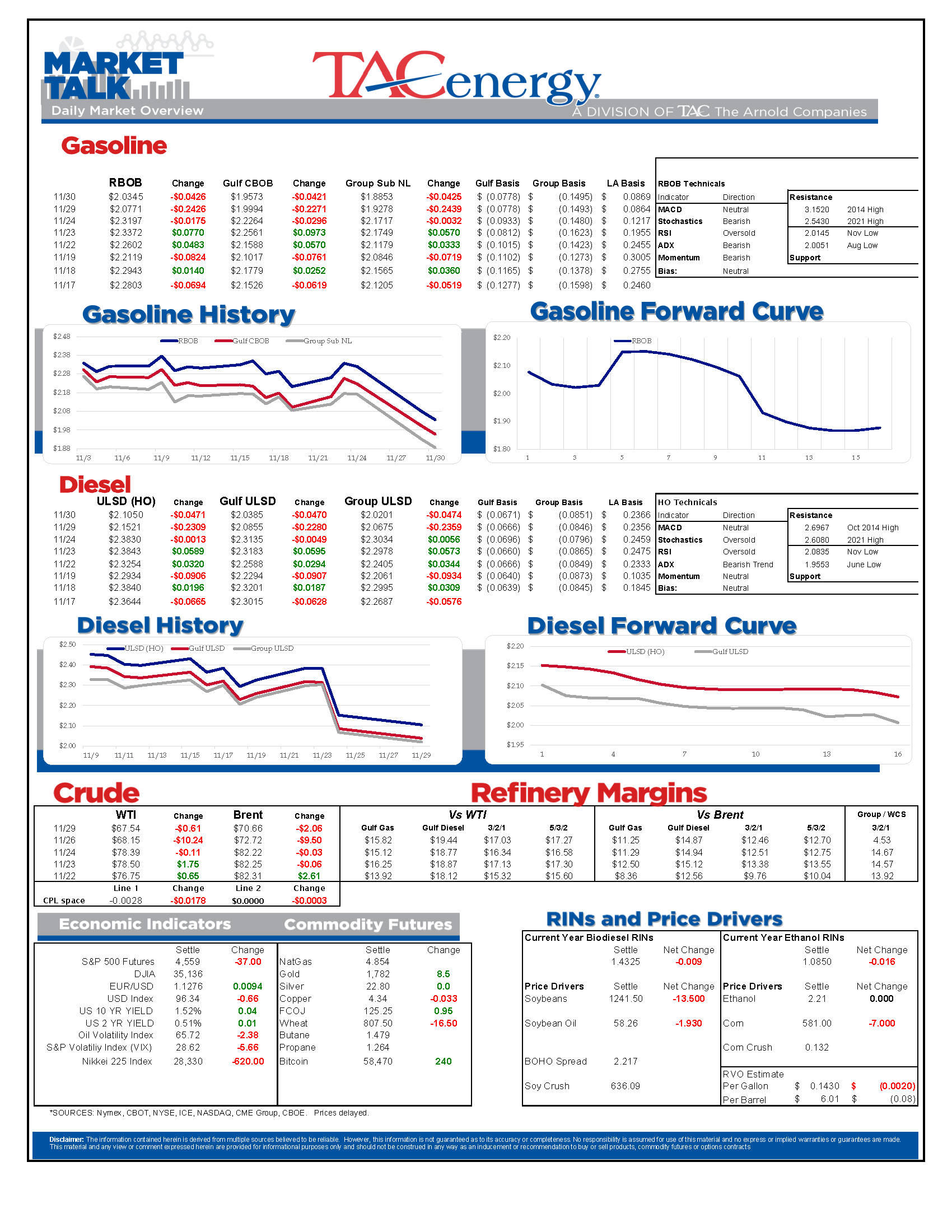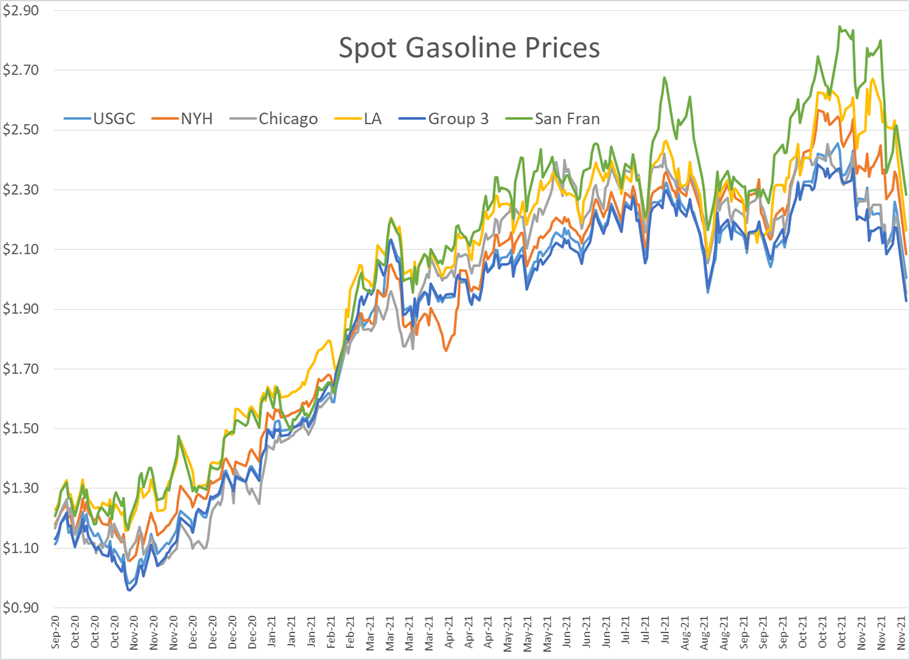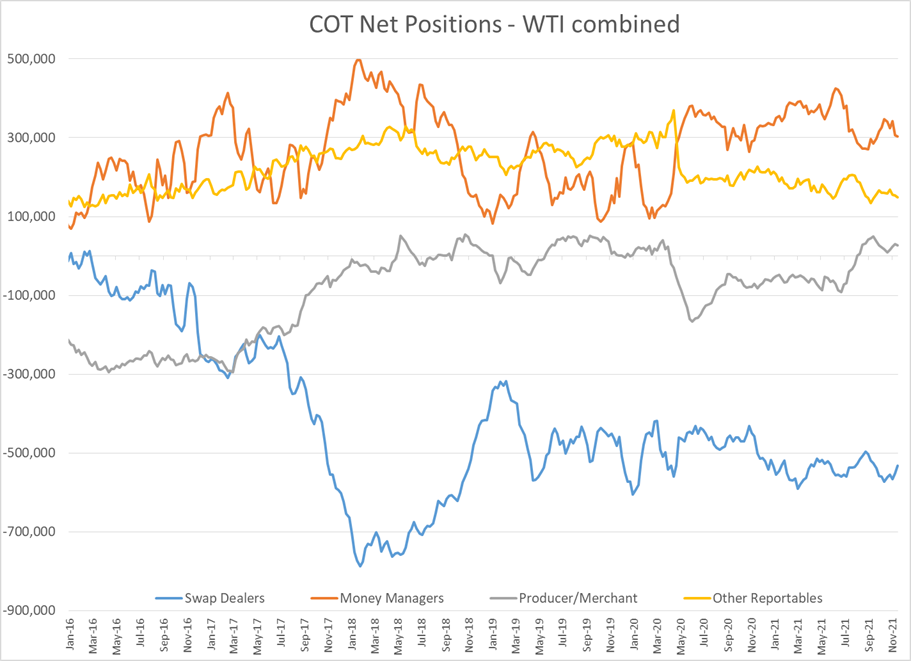Look Out Below? Energy And Equity Futures Are Pointed Sharply Lower Again

Look out below? Energy and equity futures are pointed sharply lower again Tuesday after Monday’s recovery rally started to fall apart in the afternoon hours. Omicron is once again getting credit for most of the selling, after Moderna’s CEO shared a much more pessimistic outlook for the variant than Pfizer’s CEO did Monday.
It’s the last trading day for December RBOB and ULSD contracts, and at this point, and given the heavy selling and backwardation in the market, we’re likely to see the January contracts take over the prompt position at prices we haven’t seen in 6 months or more. Already January RBOB is trading at $1.96, pushing several cash markets across the US to levels we haven’t seen since the spring RVP transition. ULSD futures meanwhile have already taken out Friday’s low trades, leaving the door open for another big push lower that may see diesel trading below the $2 mark this week as well.
The pullback in prices, and the post-holiday demand drop has also wiped out the premium to ship gasoline from the Gulf Coast to the New York harbor in just a few sessions. No such relief in ethanol however, as logistical bottlenecks keep prompt prices near the $4/gallon mark even as gasoline prices have crumbled.
It’s not just consumers who will enjoy the big drop in fuel prices: There was a big increase in new short positions in ULSD, WTI and Gasoil contracts last week ahead of the selloff, which pushed the net length held by money managers lower. A key point to watch this week will be how that length held by hedge funds weathers the selloff, as a mass liquidation often has a snowball effect pushing prices even lower.
With charts continuing to point lower and fear driving the action, the best hope for the bulls this week may come from OPEC, who postponed their technical committee meeting this week to take more time to evaluate Omicron. The cartel could pause their plans to increase crude output each month to try and stop the selloff, especially since many of its members are struggling to reach their production quotas given the supply chain issues impacting just about every industry in just about every corner of the world.
Speaking of supply chain challenges, a Reuters story this morning suggests things are about to get worse for traditional oil and gas producers as more than 40% of survey participants said they plan to leave their job in the next 5 years, with more than half of those aiming to move into renewables.
Today is the last official day of the 2021 Atlantic Hurricane Season, which ended with a whimper after a busy start that saw all of the names in the original list get used up. While this season brought us Hurricane Ida, one of the worst hurricanes on record, which continues to have impacts on oil and refined product supplies in the Gulf Coast today, the supply network is breathing a bit of a sigh of relief that things weren’t worse after 18 months of seemingly non-stop disruptions.
Click here to download a PDF of today's TACenergy Market Talk.
Latest Posts
The Sell-Off Continues In Energy Markets, RBOB Gasoline Futures Are Now Down Nearly 13 Cents In The Past Two Days
Week 15 - US DOE Inventory Recap
Prices To Lease Space On Colonial’s Main Gasoline Line Continue To Rally This Week
Equity Markets Have Been Pulling Back Sharply In Recent Days As Inflation And Trade Concerns Inject A Sense Of Reality Into Stocks
Social Media
News & Views
View All
The Sell-Off Continues In Energy Markets, RBOB Gasoline Futures Are Now Down Nearly 13 Cents In The Past Two Days
The sell-off continues in energy markets. RBOB gasoline futures are now down nearly 13 cents in the past two days, and have fallen 16 cents from a week ago, leading to questions about whether or not we’ve seen the seasonal peak in gasoline prices. ULSD futures are also coming under heavy selling pressure, dropping 15 cents so far this week and are trading at their lowest level since January 3rd.
The drop on the weekly chart certainly takes away the upside momentum for gasoline that still favored a run at the $3 mark just a few days ago, but the longer term up-trend that helped propel a 90-cent increase since mid-December is still intact as long as prices stay above the $2.60 mark for the next week. If diesel prices break below $2.50 there’s a strong possibility that we see another 30 cent price drop in the next couple of weeks.
An unwind of long positions after Iran’s attack on Israel was swatted out of the sky without further escalation (so far anyway) and reports that Russia is resuming refinery runs, both seeming to be contributing factors to the sharp pullback in prices.
Along with the uncertainty about where the next attacks may or may not occur, and if they will have any meaningful impact on supply, come no shortage of rumors about potential SPR releases or how OPEC might respond to the crisis. The only thing that’s certain at this point, is that there’s much more spare capacity for both oil production and refining now than there was 2 years ago, which seems to be helping keep a lid on prices despite so much tension.
In addition, for those that remember the chaos in oil markets 50 years ago sparked by similar events in and around Israel, read this note from the NY Times on why things are different this time around.
The DOE’s weekly status report was largely ignored in the midst of the big sell-off Wednesday, with few noteworthy items in the report.
Diesel demand did see a strong recovery from last week’s throwaway figure that proves the vulnerability of the weekly estimates, particularly the week after a holiday, but that did nothing to slow the sell-off in ULSD futures.
Perhaps the biggest next of the week was that the agency made its seasonal changes to nameplate refining capacity as facilities emerged from their spring maintenance.
PADD 2 saw an increase of 36mb/day, and PADD 3 increased by 72mb/day, both of which set new records for regional capacity. PADD 5 meanwhile continued its slow-motion decline, losing another 30mb/day of capacity as California’s war of attrition against the industry continues. It’s worth noting that given the glacial pace of EIA reporting on the topic, we’re unlikely to see the impact of Rodeo’s conversion in the official numbers until next year.
Speaking of which, if you believe the PADD 5 diesel chart below that suggests the region is running out of the fuel, when in fact there’s an excess in most local markets, you haven’t been paying attention. Gasoline inventories on the West Coast however do appear consistent with reality as less refining output and a lack of resupply options both continue to create headaches for suppliers.

Week 15 - US DOE Inventory Recap

Prices To Lease Space On Colonial’s Main Gasoline Line Continue To Rally This Week
Energy markets are sliding lower again to start Wednesday’s trading as demand concerns and weaker stock markets around the world seem to be outweighing any supply concerns for the time being.
Rumors continue to swirl about an “imminent” response by Israel to Iran’s attacks, but so far, no news seems to be taken as good news in the hopes that further escalation can be avoided, even as tensions near the Red Sea and Strait of Hormuz continue to simmer.
Prices to lease space on Colonial’s main gasoline line continue to rally this week, trading north of 11 cents/gallon as Gulf Coast producers still struggle to find outlets for their production, despite a healthy export market. Gulf Coast CBOB is trading at discounts of around 34 cents to futures, while Gulf Coast RBOB is trading around a 16-cent discount, which gives shippers room to pay up for the linespace and still deliver into the East Coast markets at a profit.
Back to reality, or just the start of more volatility? California CARBOB basis values have dropped back to “only” 40 cent premiums to RBOB futures this week, as multiple flaring events at California refineries don’t appear to have impacted supply. The state has been an island for fuel supplies for many years as its boutique grades prevent imports from neighboring states, and now add the conversion of the P66 Rodeo refinery to renewable diesel production and the pending changes to try and cap refinery profits, and it’s easier to understand why these markets are increasingly vulnerable to supply shocks and price spikes on gasoline.
RIN prices continue to fall this week, touching 44 cents/RIN for D4 and D6 values Tuesday, their lowest level in 6 weeks and just about a nickel above a 4-year low. While the sharp drop in RIN and LCFS values has caused several biodiesel and Renewable Diesel producers to either shut down or limit production, the growth in RIN generation continues thanks to projects like the Rodeo refinery conversion, making the supply in RINs still outpace the demand set by the Renewable Fuel Standard by a wide margin.
The API reported draws in refined products, 2.5 million barrels for gasoline and 427,000 barrels for distillates, while crude oil stocks had an estimated build of more than 4 million barrels. The DOE’s weekly report is due out at its normal time this morning.
Click here to download a PDF of today's TACenergy Market Talk.






